BOHEMIA
- Annalise Lecher

- May 31, 2019
- 14 min read
DAY 1
Our final class trip started with a day full of driving and stopping to tour sites along our way to our destination, Kunta Hora. The first stop we made was in Litomyšl where we visited a chateau, a church, and ate some lunch. Our time here started as our professors went to get tickets for everything and the class was left unaccompanied for 20 minutes in the courtyard. If you knew our class, you wouldn't be surprised that within minutes, Lauren was doing round offs and walkovers in the grass, and the other half of the class was climbing a tree nearby. Needless to say, we are all kids at heart! haha Our first tour of the day began at a church built in 1714. At this point, we have visited so many churches that it is hard to keep them all separate in my head so I will just share my favorite parts of this particular one! Even though it was over 300 years old, the refurbished church had a modern, yet classic, feeling to it. The restoration of this church was carried out by the restoration school that is actually connected to the church located in the old monastery. The students have done a fantastic job and as I said, have added modern touches to the classic church. There is a prism hanging in front of the altar that represents the light and life that God brings into the world. Additionally, the altar actually lights up and turns different colors to act as a living organism. After touring the Archangels Exhibit located in the balcony and climbing a million and a half stairs to the outlook over the town, we were released to get some grub!
A large group of us went into town to find a traditional Czech restaurant because we were craving svíčková, which is my favorite Czech dish. We found a Czech Bar with a cave area for food seating and looked really cool, so we decided to take a seat! Unfortunately, they did not have svíčková, so I ended up getting Řízek, which is basically fried meat, still really good with a little lemon juice drizzled over it. After a great lunch, we found our way back through town up to the Chateau to take a tour of the Litomyšl Castle.
The Litomyšl Castle is famous for many things, but especially the personal theater that was used for personal entertainment for the family. The famous theater was so different from what we see in theaters today! The complexity of scene change technology and the use of perspective to create the illusion of a bigger stage was brilliant!! I very much enjoyed the rest of the tour of the gorgeous rooms that make up the residence. The walls and ceilings were all painted with a 3D effect that made them look decorated with crown molding and other embellishments. Each room had a specific purpose and was furnished and decorated according to that specific use. After this fun little tour, it was back to the bus for us, to drive to our next stop on this little road trip across the Czech Republic!
There was a change in mood at our next stop, which was the remnants of the village of Lezaky. To give a little background, a different village of Lidice, population 503 in 1942, had existed for hundreds of years. However, after the assassination of SS Reichsprotector Reinhard Heydrich, the Nazis made a brutal move. A man serving in the Czechoslovak army in Britain was from Lidice; his family, the Horáks, remained in the village. The Gestapo unit based in the city of Kladno became suspicious that the Horák family had something to do with Heydrich’s death. They searched the house and found no sign that the family had been involved in any way with the assassination, but the Nazis wanted blood, and they were determined to have it. The first action was taken against the village of Lidice on June 10, 1942. Men of the village were shot on the spot, the women were sent to camps, and the children were put in a box truck that was designed to emit transmission fumes into the box and eventually kill all the children. As if that were not enough, they moved onto the village of Lezaky on June 24, 1942. The small town of Lezaky was attacked by German security forces and Czech collaborators for having hidden a resistance radio transmitter and commandos who had aided in the assassination of Heydrich. Forty seven men, women, and children were taken. 18 women and 15 men were shot on the spot. Others were sent to concentration and death camps like Chelmno. Buildings of this stone-working town were then destroyed by German labor front forces. After the war, two small girls and their grandfather were discovered to have survived. The children, who survived, were relocated to German families to be integrated as Germans. This is a story that happened every so often with children that the Nazis believed could be turned into good Germans. The village has now been memorialized with stone foundations where the houses used to stand. The visit was very somber with a light drizzle, cloudy skies, and a crisp bitter chill in the air.
After our mini history lesson in the field, we got on the road again and finally arrived at Kutna Hora, Czech Republic. We checked into our hotel and then Sara, Lauren, Kirsten, Alex, Cici, and I went to a coffee shop to work on our blogs (which everyone was trying to finish, and obviously, I am still behind) and get a sweet treat to eat. I love sitting around with these girlies so much, but we never seem to actually get much done while we are together, an intriguing conversation or debate always presents itself! Haha! We closed the coffee shop down and then went looking for somewhere to grab some dinner. You wouldn't think that this would be a difficult thing to do at 21:00, but in a small Czech town pretty much everything is closed at this time! With this being said, we walked our way around the town for a while before finally coming across this medieval pub that was still serving food for another 20 minutes! (Lucky us!!) This place was so cool, they served meat on swords, had themed decorations, and the waitresses were wearing authentic clothing. It felt like we were eating in a medieval brothel! I ended the day right, getting to eat my favorite dish of svíčková. Since most of you don't know, svíčková is basically meat covered in a sweet sauce, served with bread dumplings (kdnikly), lemon, jam, and whipped cream.
DAY 2
The second day of our trip started with a wonderful breakfast at our hotel followed by a tour of The Cathedral of Assumption of Our Lady and Saint. Compared to the other cathedrals that we have visited, this one was relatively plain. The stain glass was very simple, completely clear with only colors around the edges which was very different to the ordinary stain glass windows depicting scenes from biblical stories. Next on our tour of the day, was a very odd church. (I know what you’re thinking, “they visit a lot of churches” and yes you’re right, we do! Haha but this one was way cool!) Sedlec Ossuary is a small Roman Catholic chapel, located beneath the Cemetery Church of All Saints, in a suburb of Kutna Hora. This little chapel is home to an estimated 40,000-70,000 skeletons that welcomed us in with open arms, LITERALLY! Thus, it is also known as the Church of Bones or as the Bone Church.
One of the most fascinating artistic works inside the Sedlec Ossuary is the big chandelier of bones that lies in the center of the Church of Bones. The immense chandelier contains at least one of every human bone and is intricately designed, I couldn't help but stare at it for a while. You may wonder how all these bones ended up being crammed in a small chapel located in the Czech Republic, or at least I did. It all goes back to 1278 when the King of Bohemia sent the abbot of the Sedlec Cistercian Monastery to Jerusalem. When the abbot came back he brought with himself a jar of soil from the Golgotha, that was known as the “Holy Soil”. Soon people from all over desired to be buried in Sedlec, thus the cemetery here had to be expanded. In the 15th century, a Gothic church was built near the cemetery and its basement was used as an ossuary.An ossuary is a chest, box, building, well, or site made to serve as the final resting place of human skeletal remains.The bones stayed here for centuries till 1870 when a woodcarver named Frantisek Rint was appointed to place the bones in order. The result is what we see today! Unlike you may think, the atmosphere of this chapel is not eerie, but somewhat peaceful, if you can get over how many dead people it took to create such a masterpiece. HA!

When we got back to the main part of town we walked past a beautiful example of a well from 1497! In order to get water from this water well, the townsfolk would have to go into the building and draw water during the day, even though there was a nozzle on the outside of the structure. The water was very regulated and controlled due to the fear of contamination during the Black Plague. People from all over Europe were convinced that Jews were going from town to town contaminating the wells during the night. This is a great example of early anti-semitic ideology that has repeated itself over and over throughout history.
Continuing on through this extremely packed day, our third cathedral of the day was St Barbara's Church. Construction began in 1388, but because work on the church was interrupted several times, it was not completed until 1905! I thoroughly enjoyed the architecture of this cathedral with its gothic style of high ceilings and elongated stain glass windows. Each one of these enormous stain glass windows was donated by a family or a company which means that they all have a slightly different style due to completion by different artists. I thought these pieces of artwork were absolutely stunning and rank in my top 10 favorite cathedrals. In particular, this cathedral reminded me of the Prague Castle and its gorgeous stained glass masterpieces. They say that because of its placement up on a hill, and with the silver mines under the whole town, the church is very slowly falling off the hillside. Obviously they are taking precautions to preserve it, but I found that very interesting and scary.
After the march of churches in the morning, we were released for a break to eat before touring the Silver Mines of Kutna Hora. A large group of us again found an authentic Czech restaurant with a medieval lodge theme. Honestly, it felt like I was eating in the castle of the Disney movie Brave! We sat on fur pelts, were surrounded my old metal weapons, and had dramatic medieval music surrounding us. I had a bowl of Czenicá polevka (garlic soup), which is also a personal favorite traditional Czech dish. After finishing up with lunch, we walked around and did a little shopping before heading to the Silver Mine to meet the rest of our group for the tour!
For this mine tour, we got to put on canvas white kirtle, so-called perkytle – the traditional clothing of miners, with helmets and headlamps. Our entire class then shimmied through the super narrow and at times short tunnels that made up this medieval mine. Our wonderful tour guide showed us what it was like to be in the mines in the complete dark and told us some spooky legends with the lighting of one flickering candle. The mines were wet, super small, and muggy. Again, I could not imagine having to work in a space this small for 8+ hours. But, it was really fun to explore our way through these twisting tunnels.
The rest of my evening included sitting at a cafe with five girlies trying to write in my journal, but also having conversations about controversial topics in the world today! I think it is so important for my generation and everyone else to have the ability to sit down with people of opposing opinions and openly communicate beliefs and ideas back and forth! Later that evening we all went to get some bomb sushi and played a game of cards (called hearts) in the lobby of our hotel! FUN TIMES!!
DAY 3
We departed from Kutna Hora in the morning to begin our journey towards Cesky Krumlov. Of course, we made a couple of stops along the way to make the journey a little bit more fun for all us kids! ;) The first stop was in Trebon Czech Republic where we walked through some gorgeous gardens, visited a man-made lake, ate lunch, and of course, also had some good European gelato. After this quick little pit stop, we were back on the road to visit the Budweiser factory.
Contrary to what you’re probably thinking, this is not the same Budweiser that we have in the United States. It goes like this, two beer companies (from the Czech Republic and the United States) each claim the trademark and geographic origin rights to the name "Budweiser", the Budweiser trademark dispute is an ongoing series of legal disputes between the two companies. The dispute has been ongoing since 1907 and has involved more than 100 court cases around the world. As a result, Budweiser Budvar (Czech Budweiser) has the rights to the name “Budweiser” in most of Europe and Anheuser-Busch InBev (American Budweiser) has this right in North America. Consequently, AB InBev uses the name "Bud" in most of Europe and Budvar sells its beer in North America under the name "Czechvar". In other territories, one or other or even both may use the name, depending on local trademark law. The tour was very interesting, and informative as we had the cutest tour guide ever! Unfortunately, I can't remember her name, but she was a retired grade school teacher who started giving tours at the factory because she just needed to be around people! The Czech Budweiser beer was not personally my favorite, but I know a lot of my classmates really enjoyed the fresh sample that we got straight from the aging containers!
After a couple more hours on the bus, we finally arrived at our destination of Cesky Krumlov. After walking through town to get to our hostel, we explored the quaint little town in small groups before sitting down somewhere for a much needed dinner. The six of us girls found a real gem of a restaurant for our first night here. I had a scrumptious caesar salad which was so refreshing compared to all of the heavy Czech food I had been eating! Like normal, we sat there for an extended amount of time talking and laughing before heading back to the hostel for the night. Lauren and Alex were my roomates for the time we were here, and boy did we have some funny moments! For example, we have concluded that Lauren has arachnophobia because she has freaked out over spiders and bugs so much during our time together! During this night, in particular, she was literally checking her bed for spiders and stuffing a blanket in between her bed and the wall in order to prevent them for being able to get to her! She also started talking in the middle of the night because she thought there was a spider next to her! LOL What a funny girl that I was so blessed to be able to get to know through this experience!

DAY 4
The fourth and final day of our trip started with a walking tour of the town which led up to the Castle of Český Krumlov. The original Gothic castle was founded by the Lords of Krumlov some time before 1250. They represented a branch of the powerful family of the Witigonen with the five-petaled rose in their coat-of-arms. When the Lords of Krumlov died out in 1302, their relatives, the Rosenbergs, inherited the castle. The Rosenbergs family had their seat there till 1602. Their name, as well as the three centuries of their rule, is connected with the greatest era of flourish of the town and castle. In the second half of the 16th century, the castle acquired the form of a mighty and splendid Renaissance residence. At that time the rulers of the Rosenberg dominion represented eminent personalities among Bohemian aristocracy, educated humanists, patrons of the culture and arts, and the politicians all filling the highest posts within Bohemian Kingdom.
Skipping forward in history about 100 year, the Eggenberger died out without successors in 1719, the new dynasty - the princely lineage of the Schwarzenberga - inherited Krumlov. As early as in their second generation Joseph Adam zu Schwarzenberg showed his creative personality. A deft and enterprising businessman as well as a passionate art lover, he played an important role in the far-reaching reconstructions of the castle. His inspiration came a lot from the culture of the imperial residence in Vienna. Towards the end of the 18th century, and especially in the 19th century, the protracted stagnation of art and economy became evident, and after the middle 19th century the Český Krumlov Castle lost its role as the main residence of the Krumlov-Hluboká Schwarzenberg branch and was not regularly inhabited even in the 20th century. In 1947, the Schwarzenberg property, including Český Krumlov, was transferred to the Czech provincial properties and after the abolition of the provincial system it became the property of the Czechoslovak State in 1950.
One of the major traditions that we learned about during our tour of this magnificent castle was that of the guard bears. For over 500 years, the castle has been guarded by bears who live in a moat type structure in front of the entrance to the castle. Currently there is only one bear living here, but there has been as many at 4 living here at one time. The bears are a symbolic part of the castle and stay with it even after they die. Once the bears die, of either old age or whatever it may be, they are turned into a new fur rug for the castle. During our tour we were able to see the many, many bear pelts scattered throughout each room in the castle. I thought it was really interesting to see how much the taxidermy methods have improved throughout the years! Unfortunately, we weren’t allowed to take any pictures of the facility. This always makes me sad as I love sharing my experiences with you all through words and pictures because it helps the story come to life!
Our tour of the castle concluded with a tour of the theater next to the castle which was spectacular! In 1675 Prince Johann Christian I. von Eggenberg had a theatre scene built in the so-called Deer Hall in the Krumlov castle, this room is now a beautifully painted ballroom. The theater was rebuilt in 1680 - 82 in the 5th courtyard so that it would be seperate from the main castle. The reason for doing so was to eliminate the chance of having a fire hazard. The theater was lit by candles and therefore ran a chance of catching fire, so Prince Johann Christian I wanted to have the building separate from the main castle. In 1765 - 1766, Josef Adam zu Schwarzenberg had the building reconstructed and equipped it with new machinery and decorations. The unique mechanisms for changing the scenes and other decorations that we were able to see were amazing! The entire set can be changed within a couple of seconds and has many variations of settings that can be created. The wall paintings, ceiling mural, curtains and wings were all just drop dead gorgeous! For how old this theater is, it was intriguing to see the amount of technology that they came up with to make actors appear, and disappear, weather storms appeaR, and the seamless change of scenes throughout the plays! This theater is and was mostly used in the spring and summer months for holiday festivals. During our tour I even got to help create a “storm” with the sound tools that they use for productions!
After all this fun, we took a break for lunch, where I ordered a traditional fish dish for the area. Unlike in America, when you order a fish here, you actually get a whole fish placed right on your plate, scales, eyeballs, bones, the whole nine yards! My father would be proud to know that I cleaned out the fish like a champ, almost getting all the meat and no bones when I was eating (realize that I did say ALMOST) haha. I ate with Lauren, Sara, Alex, Cici, Kirsten, and Professor Mims. After a delicious meal we headed back to the hostel to get ready to go RAFTING!!!

Rafting was our last class trip thing to do together! The weather so kindly warmed up for the last part of our trip! So the day was complete with warm sun, cool water, and great company. We floated down the river for about 5 hours with a couple of stops at campsites where we sat around a campfire and ate hot dogs (the Czech version of course). Five hours that were packed full of memories that I will never forget, but also that should probably not be posted to the internet. So I will just leave you with the joy of our faces, and the beauty of the scenery in these pictures! Hahaha After this trip I understood why they call Český Krumlov the hidden gem of the Czech Republic!
Blessings and Hugs,
Annalise Lecher


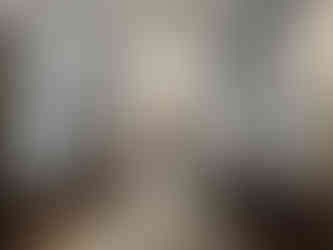










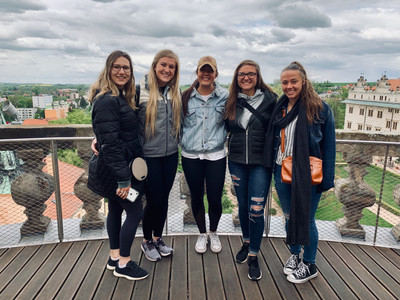







































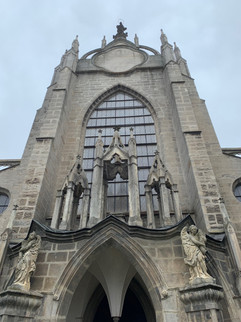





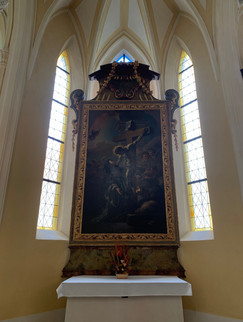
























































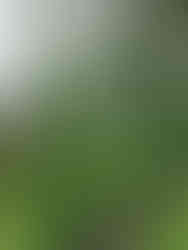




































Comments